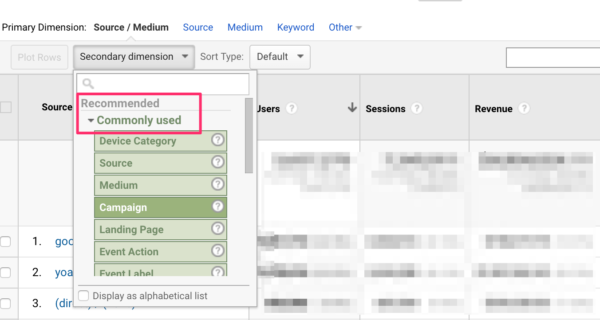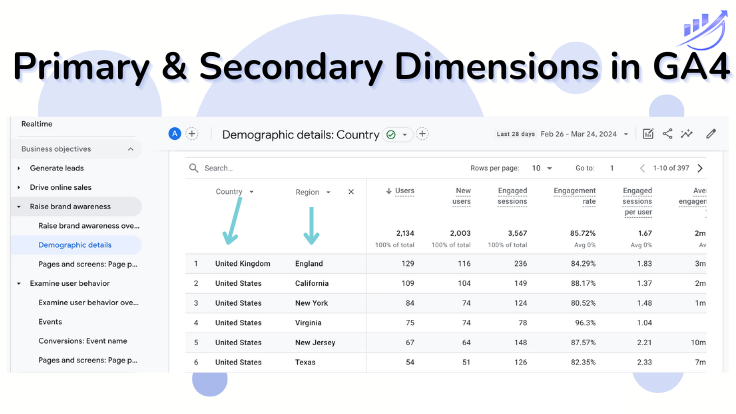Necessary Understanding: 'Secondary Dimensions' in Google Analytics Explained
Necessary Understanding: 'Secondary Dimensions' in Google Analytics Explained
Blog Article
Demystifying Secondary Dimension in Google Analytics: The Key to Understanding Your Information Like Never Prior To
In the realm of digital analytics, the ability to extract purposeful insights from data is paramount for notified decision-making. Among the plethora of tools readily available, Google Analytics sticks out as a giant, yet numerous individuals stay unaware of the untapped potential lying within its Second Dimension feature. By peeling off back the layers of complexity bordering this tool, an entire brand-new globe of information analysis and evaluation reveals itself. Comprehending the subtleties of Additional Measurement can be the missing out on item in your analytics puzzle, clarifying fads and connections that were previously obscured.
Comprehending the Fundamentals of Secondary Dimension
Secondary measurements in Google Analytics function as auxiliary qualities that supply much deeper understandings right into key data metrics, improving the total understanding of user habits and interactions on a web site. By adding second measurements to your primary information metrics, you can sector and examine your information better, uncovering useful information that might have been concealed or else.
Understanding the fundamentals of additional dimensions is essential for enhancing your website's performance and user experience. what is a “secondary dimension” in google analytics?. When making use of secondary dimensions, it is necessary to recognize that they can be included in numerous reports in Google Analytics, enabling you to discover added elements of your data beyond the conventional measurements
Moreover, second measurements enable you to contrast and contrast different information factors, aiding you identify patterns, patterns, and correlations that can educate your advertising and marketing approaches and website optimizations. Whether evaluating traffic resources, individual demographics, or behavior on details web pages, second measurements play a pivotal role in extracting purposeful insights from your Google Analytics information.
Using Secondary Measurement in Reports
To deepen the evaluation of user behavior and interactions on a site, integrating additional measurements into records in Google Analytics provides a more detailed understanding of data metrics. By using secondary dimensions in records, analysts can uncover beneficial insights that surpass the surface-level data provided by key measurements alone. This attribute enables individuals to section and pierce down into their information further, revealing connections and patterns that might have or else gone unnoticed.
With the application of second dimensions, customers can acquire a much deeper understanding of the context bordering their key data points. Combining the key dimension of 'source/medium' with a second measurement like 'landing page' can reveal which certain touchdown web pages are driving traffic from various sources. This degree of granularity can help online marketers tailor their strategies to enhance performance based on these in-depth understandings.
Analyzing Data With Additional Dimension
Making use of secondary dimensions in information analysis boosts the depth of understandings derived from Google Analytics reports. By including a secondary dimension to your main data sets, you can uncover important connections and patterns that may otherwise continue to be undetected. This added layer of information permits for even more nuanced analyses of customer actions, traffic resources, and other essential metrics.
When evaluating information with secondary dimensions, it is important to concentrate on relevant combinations that line up with your certain objectives. Combining the primary measurement of 'landing web pages' with a secondary measurement like 'tool classification' can expose just how different gadgets influence the efficiency of different touchdown pages. This type of evaluation can lead to workable understandings, such as optimizing page layouts for specific tools to enhance overall individual experience and conversion prices.
Moreover, leveraging secondary dimensions allows you to segment and contrast data better, supplying an extensive sight of your internet site's performance from different angles. This complex strategy to data analysis encourages businesses to make educated decisions and customize their strategies for optimal influence.

Advanced Techniques With Secondary Measurement
Discovering intricate data partnerships through second he has a good point measurements unlocks sophisticated logical capacities in Google Analytics. By combining secondary measurements purposefully, analysts can delve much deeper into their information and remove useful understandings. One innovative technique includes using additional measurements to section data additionally, making it possible for an extra granular evaluation of customer habits. Coupling the key measurement of 'Source/Medium' with the secondary measurement of 'Device Group' can expose how various devices contribute to website traffic from numerous sources.
Additionally, employing second dimensions together with filters permits more accurate information control. Filtering data by details criteria and after that including additional measurements can give a more clear photo of customer interactions based on different characteristics. This method is particularly valuable for recognizing patterns or anomalies within fractional information collections.
In addition, making use of second measurements in personalized reports or dashboards can improve the evaluation process and facilitate the monitoring of crucial performance indications across different dimensions. By customizing records with second dimensions, analysts can focus on certain metrics tailored to their special analytical requirements, enhancing the general data interpretation and decision-making procedure.
Enhancing Data Analysis With Secondary Measurement
Enhancing data interpretation with second dimensions in Google Analytics offers a much deeper understanding of individual behavior and insights into key efficiency metrics. what is a “secondary dimension” in google analytics?. By making use of additional measurements, analysts can section and filter their data to uncover useful patterns and patterns that might not be promptly noticeable when taking a look at the information in its primary kind. This improved degree of granularity enables for a more thorough analysis of individual interactions on a site or application
Second measurements can be specifically useful in isolating certain variables that may impact individual actions, such as the source of traffic, tool type, or geographical area. By layering these extra dimensions onto key data collections, experts can obtain an extra nuanced point of view on exactly how different variables influence user involvement and conversion prices.
Conclusion
To conclude, making use of the additional measurement attribute in Google Analytics offers a much deeper level of understanding right into site information by allowing customers to examine information from numerous viewpoints. By using secondary dimensions in records, assessing data, and utilizing sophisticated techniques, individuals can boost their data interpretation and make even more informed choices for their websites - what is a “secondary dimension” in google analytics?. Recognizing and leveraging additional measurements is vital for obtaining a thorough understanding of website performance and user habits

In conclusion, making use of the additional dimension feature in Google Analytics provides a deeper level of understanding right into visit this site website data by permitting individuals to evaluate data from several viewpoints.
Report this page